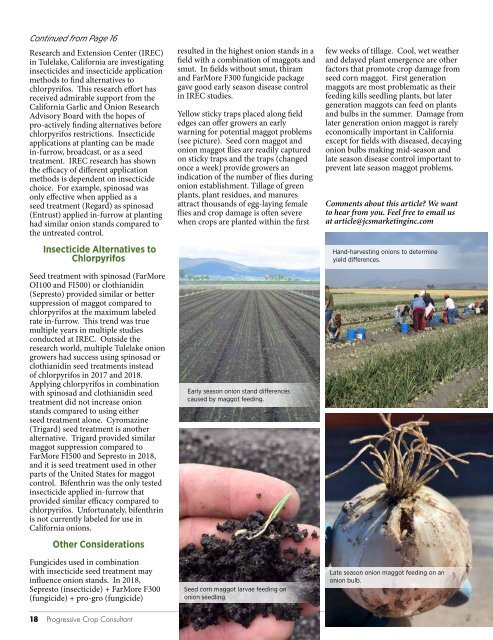PCC March 2019
Create successful ePaper yourself
Turn your PDF publications into a flip-book with our unique Google optimized e-Paper software.
Continued from Page 16<br />
Research and Extension Center (IREC)<br />
in Tulelake, California are investigating<br />
insecticides and insecticide application<br />
methods to find alternatives to<br />
chlorpyrifos. This research effort has<br />
received admirable support from the<br />
California Garlic and Onion Research<br />
Advisory Board with the hopes of<br />
pro-actively finding alternatives before<br />
chlorpyrifos restrictions. Insecticide<br />
applications at planting can be made<br />
in-furrow, broadcast, or as a seed<br />
treatment. IREC research has shown<br />
the efficacy of different application<br />
methods is dependent on insecticide<br />
choice. For example, spinosad was<br />
only effective when applied as a<br />
seed treatment (Regard) as spinosad<br />
(Entrust) applied in-furrow at planting<br />
had similar onion stands compared to<br />
the untreated control.<br />
Insecticide Alternatives to<br />
Chlorpyrifos<br />
Seed treatment with spinosad (FarMore<br />
OI100 and FI500) or clothianidin<br />
(Sepresto) provided similar or better<br />
suppression of maggot compared to<br />
chlorpyrifos at the maximum labeled<br />
rate in-furrow. This trend was true<br />
multiple years in multiple studies<br />
conducted at IREC. Outside the<br />
research world, multiple Tulelake onion<br />
growers had success using spinosad or<br />
clothianidin seed treatments instead<br />
of chlorpyrifos in 2017 and 2018.<br />
Applying chlorpyrifos in combination<br />
with spinosad and clothianidin seed<br />
treatment did not increase onion<br />
stands compared to using either<br />
seed treatment alone. Cyromazine<br />
(Trigard) seed treatment is another<br />
alternative. Trigard provided similar<br />
maggot suppression compared to<br />
FarMore FI500 and Sepresto in 2018,<br />
and it is seed treatment used in other<br />
parts of the United States for maggot<br />
control. Bifenthrin was the only tested<br />
insecticide applied in-furrow that<br />
provided similar efficacy compared to<br />
chlorpyrifos. Unfortunately, bifenthrin<br />
is not currently labeled for use in<br />
California onions.<br />
Other Considerations<br />
Fungicides used in combination<br />
with insecticide seed treatment may<br />
influence onion stands. In 2018,<br />
Sepresto (insecticide) + FarMore F300<br />
(fungicide) + pro-gro (fungicide)<br />
resulted in the highest onion stands in a<br />
field with a combination of maggots and<br />
smut. In fields without smut, thiram<br />
and FarMore F300 fungicide package<br />
gave good early season disease control<br />
in IREC studies.<br />
Yellow sticky traps placed along field<br />
edges can offer growers an early<br />
warning for potential maggot problems<br />
(see picture). Seed corn maggot and<br />
onion maggot flies are readily captured<br />
on sticky traps and the traps (changed<br />
once a week) provide growers an<br />
indication of the number of flies during<br />
onion establishment. Tillage of green<br />
plants, plant residues, and manures<br />
attract thousands of egg-laying female<br />
flies and crop damage is often severe<br />
when crops are planted within the first<br />
Early season onion stand differences<br />
caused by maggot feeding.<br />
Seed corn maggot larvae feeding on<br />
onion seedling.<br />
few weeks of tillage. Cool, wet weather<br />
and delayed plant emergence are other<br />
factors that promote crop damage from<br />
seed corn maggot. First generation<br />
maggots are most problematic as their<br />
feeding kills seedling plants, but later<br />
generation maggots can feed on plants<br />
and bulbs in the summer. Damage from<br />
later generation onion maggot is rarely<br />
economically important in California<br />
except for fields with diseased, decaying<br />
onion bulbs making mid-season and<br />
late season disease control important to<br />
prevent late season maggot problems.<br />
Comments about this article? We want<br />
to hear from you. Feel free to email us<br />
at article@jcsmarketinginc.com<br />
Hand-harvesting onions to determine<br />
yield differences.<br />
Late season onion maggot feeding on an<br />
onion bulb.<br />
18 Progressive Crop Consultant <strong>March</strong>/April <strong>2019</strong>


















